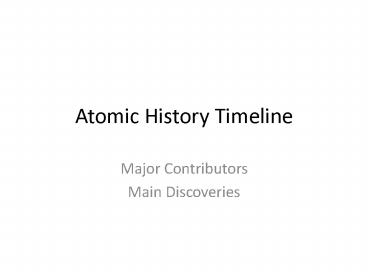Atomic History Timeline - PowerPoint PPT Presentation
1 / 16
Title:
Atomic History Timeline
Description:
Atomic History Timeline Major Contributors Main Discoveries Objectives 4.1.1) List the main points of Dalton s Atomic Theory and describe which parts are still ... – PowerPoint PPT presentation
Number of Views:351
Avg rating:3.0/5.0
Title: Atomic History Timeline
1
Atomic History Timeline
- Major Contributors
- Main Discoveries
2
Objectives
- 4.1.1) List the main points of Daltons Atomic
Theory and describe which parts are still
believed to be true - 4.1.2) Explain the atomic models of the following
scientists Dalton, Thomson, Rutherford, Bohr,
Schrödinger - 4.1.3) Describe the experiments performed by
Thomson and Rutherford and what the observations
suggested about the structure of the atom - Explain the contributions of the following
scientists to the development of the Atomic
Theory Democritus, Crookes, Becquerel, Curie,
Millikan, Chadwick
3
Democrituss Theory(Foundation of Atomic Theory)
- Thought that all things were made of tiny,
invisible, indestructible particles, called atoms
- Thought atoms varied in size, shape and weight
4
Aristotle's Theory
- Opposed the Atomic Theory
- Thought matter was made of air, water, fire, and
Earth
5
Daltons Atomic Theory
- Chemical elements are made of atoms
- Atoms are indestructible (cant be divided into
smaller parts) - Atoms have no electric charge
- Each atom of the same element is identical
- When elements react, their atoms combine in
simple, whole-number ratios
6
Crookes Tube
7
Henri Becquerel
- When Becquerel placed uranium salt in a desk
drawer with a photographic plate, radiation from
the uranium formed an image on the plate. - This proved that radiation could occur without
outside energy such as the sun - When he placed metal between the uranium and
photographic plates, the metal blocked the
radiation - Discovered natural radiation
- Discovered that a magnetic field could block
radiation
8
Marie Curie
- Confirmed the work of Becquerel
- Invented the term radioactivity
- Discovered two new elements polonium and radium
in 1898. - Her research indicated that some atoms are
unstable and will disintegrate over time on their
own. - If they fall apart, the must not be the smallest
piece of matter out there
9
JJ Thomson
- Discovered electrons using the Cathode Ray Tube
(CRT) - Beam will bend towards a positive charge,
therefore, it must be made of negatively charged
particles
10
Thomsons Atomic ModelPlum Pudding Model
- He realized that neutral atoms must have equal
amounts of positive and negative charge. - His model shows negative charges as plums and
positive charges as the pudding.
11
Rutherford's Gold Foil Experiment
- Consisted of shooting alpha particles (positive
charge) at a very thin piece of gold. - Most went straight through, some deflected at an
angle, and a small percentage bounced straight
back
12
Rutherfords Contribution to Atomic Theory
- Atoms are mostly empty space.
- Atoms have a tiny dense center called the
nucleus. - Nucleus contains most of the mass of an atom.
- Electrons are found outside of the nucleus.
- Nucleus is positively charged.
13
Bohrs Atomic Model
- Electrons exist in orbits around the nucleus
- Electrons can sometimes jump from one orbit to
another by gaining or releasing energy
14
Robert Millikan
- Discovered mass and electric charge of the
electron by using the Falling Drop Method
15
Erwin Schrödinger
- Stated that one could only predict the
probability of where an electron could be (based
on a mathematical formula), not its exact
location - These probabilities form a region of space around
the nucleus that he called orbitals (the most
probable location of the electrons).
16
James Chadwick
- Discovered the neutron in 1932
- Neutrons have approximately the same mass as
protons - Neutrons have no electric charge































